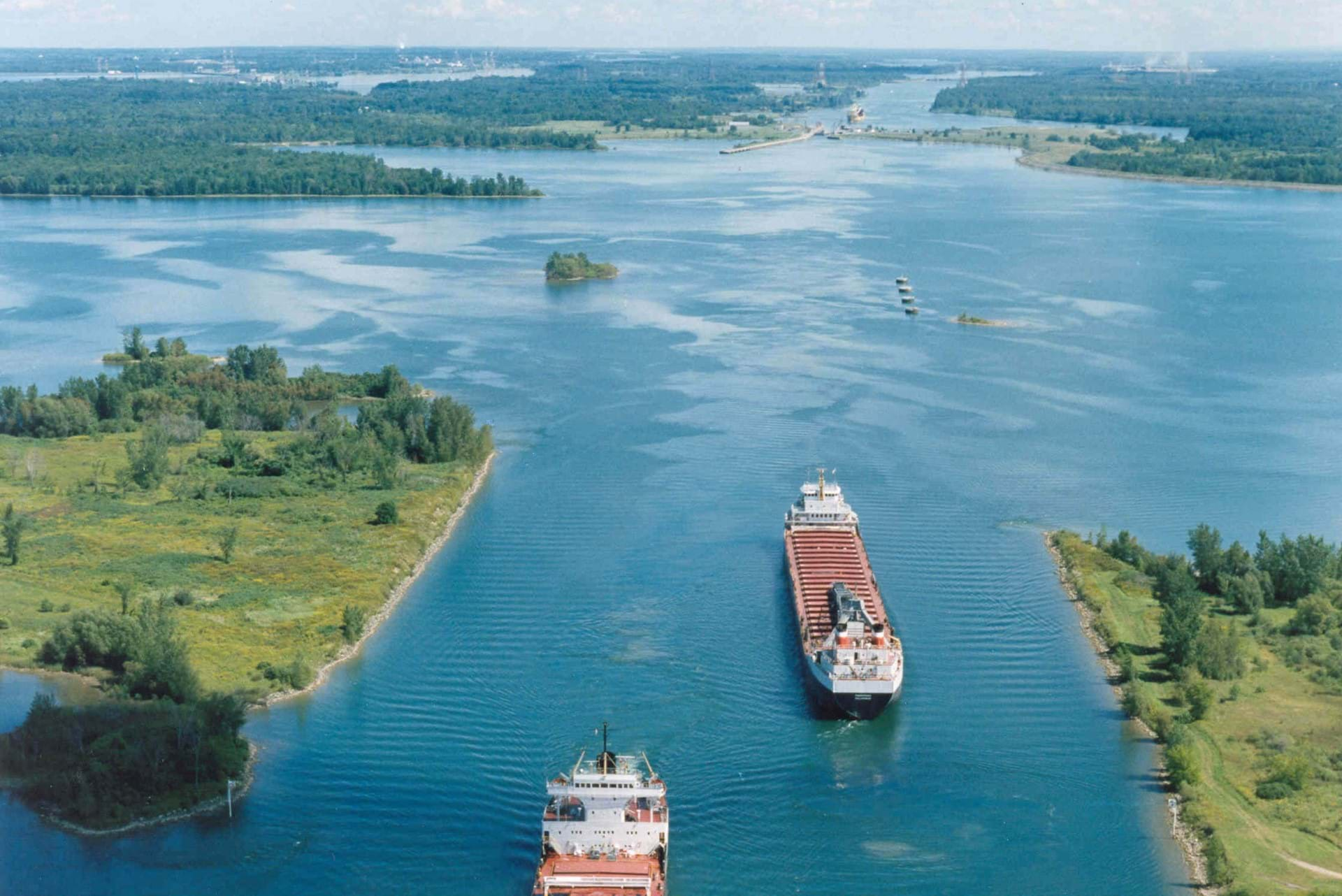
Green Shipping Corridors — Great Lakes & St. Lawrence
DecarbonizationCanada and U.S. agree to foster a clean energy network within the Great Lakes and St. Lawrence
At the United Nations Climate Change Conference (Conference of Parties or COP27) in early November, the Canadian and U.S. governments agreed to establish a Green Shipping Corridor Network in the Great Lakes and St. Lawrence Seaway system.
The news is welcomed by industry leaders who have been seeking a cohesive approach to collaborate and coordinate the massive transition required to decarbonize maritime transportation by 2050 and, if at all possible, sooner to limit global warming, but the enthusiasm comes with caveats.
“We’re pleased to see that both governments are fully on board with the concept as it makes sense to treat the Great Lakes-St. Lawrence Seaway as the established binational network that has been for decades,” says Bruce Burrows, the President and CEO of the Chamber of Marine Commerce (CMC), which spearheaded the approach.

"Now we need to act promptly, to showcase examples of what we have been and will be doing to green the corridor, and to ensure that the criteria for progressively moving our industry towards decarbonization make sense for this region."
Canada released its national vision in the Canadian Green Shipping Corridors Framework in early November with the goal of consistently implementing such corridors in ways that empower the relevant stakeholders to work together to eliminate air emissions. The U.S. Department of State released the Green Shipping Corridors Framework for the United States last April.
Transport Canada deems green shipping corridors as essential for promoting the adoption of zero-emission technologies and fuels that will allow the shipping sector to contribute towards the worldwide goal of preventing global temperature from rising by more than 1.5° Celsius. The U.S. government similarly envisions green shipping corridors as maritime routes that showcase low- and zero-emission lifecycle fuels and technologies with the ultimate goal of having zero greenhouse gas (GHG) emissions across all of a corridor’s aspects in support of industry-wide decarbonization no later than 2050.
Under the new agreement, the U.S. Department of Transportation, the U.S. Department of State, and Transport Canada have pledged to work collaboratively with state and provincial governments, Indigenous peoples, local communities, private-sector interests, as well as non-governmental leaders to facilitate the necessary consultations with ports and other stakeholders while establishing the corridor’s network.
Our intention is to facilitate discussions, not to dictate terms
“Transport Canada has taken a technology neutral approach,” Morin added. “The department is open to exploring all alternatives of energy sources, as long as they result in actual measurable reductions in GHG emissions, calculated using well-to-wake lifecycle assessment methods, without creating pollution elsewhere or pressure on food security.”
Collaboration is a daunting task to undertake with more than 110 commercial ports of various sizes and resources in Canada and the U.S. forming the world’s longest deep draft navigational system. “Yet it makes sense to focus strategically on this region that is already networked so well in so many ways, which is why we’ve been calling on government to help us with this,” Burrows says.
Progressively greening the corridor would significantly reduce GHG and other emissions incurred with moving upwards of 180 million metric tons (200 million net tons) of freight along the 3,700-kilometre (nearly 2,300-mile) stretch annually now and the higher volumes possible in future.
“Among the initial steps for ship owners and ports would be to build on their work as participants in the Green Marine environmental program that is a source of pride to many of our participating CMC members,” Burrows says.
Green Marine has the networks and capacity to develop the metrics to track the progress being made in a green corridor.
Burrows says having government support available is also essential. “For example, we’d like to see changes made to Canada’s National Trade Corridors Fund, along with its U.S. equivalents, so that ports can apply for funding to introduce or expand their plug-in shore power capabilities for vessels,” he says.
The Great Lakes and St. Lawrence Seaway region is also a key point of interest in terms of establishing transatlantic corridors with European partners. However, Burrows emphasizes the need to approach decarbonization in a way that recognizes the challenges faced by different geographic regions.
“Domestic traffic in the Great Lakes and St. Lawrence Seaway is essentially a shortsea model of shipping with smaller vessels specifically designed to be compatible with the Seaway infrastructure and moving quickly in and out of one port to the next,” Burrows notes. “Therefore, the rating system designed to rank the fuel efficiency of large oceangoing ships that travel much greater distances just doesn’t work for the fleets in the Great Lakes–St. Lawrence region.”
Burrows notes that a fleet averaging approach worked well in the past in having the vessels in the Great Lakes and St. Lawrence achieve globally required reductions in sulphur emissions.
The CMC would also like to see carbon credits granted to shippers who use the green shipping corridor, which is already the most efficient mode, and will be progressively more so as cleaner sources of energy to power ships are integrated.
How any of these measures could apply to foreign vessels using the corridor is another big question. Conceptually, as a network of clean energy hubs, the corridor might help both domestic and foreign ships by providing alternative fuels.
Already significant movement is afloat to establish green shipping corridors across the Atlantic. At the COP26 in November 2021, the Montreal Port Authority and the Port of Antwerp signed a cooperation agreement to support the first green shipping corridor in the North Atlantic.
“The St. Lawrence port and marine ecosystem is well positioned to use, distribute and export renewable fuels such as hydrogen and methanol produced using Quebec hydropower,” Martin Imbleau, the Montreal Port Authority’s President and CEO, stated when the agreement was announced.

“Our green energies can serve vessels and international markets alike,” Imbleau added. “This agreement makes it possible for us to build on our respective strengths to decarbonize not only our industry, but also our respective economies.”
This past August, the Port of Belledune in New Brunswick announced that it had reached an agreement in principle with Cross River Infrastructure Partners to build a hydrogen production facility at its northern New Brunswick port with a keen interest in supplying the fuel to customers in Germany.
On September 29th, the Port of Halifax announced its agreement to collaborate with the Port of Hamburg to decarbonize its North Atlantic shipping corridor. (See: Halifax and Hamburg port authorities team up to decarbonize shared North Atlantic corridor.)
The keen interest in developing hydrogen facilities in the Atlantic provinces, as well as the memorandums of understanding with European ports, raise interesting questions of where exactly the Canada/U.S. green shipping corridor should ideally have its entranceway.
“Partners of a corridor could extend it to an overseas port, if desired,” Morin says.
Transport Canada supports ambitious actions in establishing and expanding green corridors.
With 24 international governments having already signed declarations to establish green shipping corridors between two or more ports as of mid-November, other Green Marine participants will likely find themselves discussing strategies for decarbonization routes imminently.
“One thing is for sure: there’s no time to waste,” Burrows says. “There needs to be significant commitment and investment made by all the relevant stakeholders to ensure this huge transition happens by 2050 and keeps our industry and the world sustainable.”
___________________
READ MORE ON THIS TOPIC:
Halifax and Hamburg port authorities team up to decarbonize shared North Atlantic corridor
